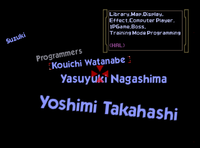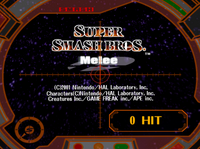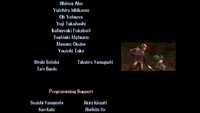Credits: Difference between revisions
No edit summary |
|||
| (153 intermediate revisions by 63 users not shown) | |||
| Line 1: | Line 1: | ||
{{ArticleIcons| | {{ArticleIcons|allgames=y}} | ||
The ''' | The '''credits''' are a feature shown at the end of a game that list the cast and staff members who worked on it. ''[[Super Smash Bros.]]'', ''[[Super Smash Bros. Melee]]'', ''[[Super Smash Bros. 4]]'', and ''[[Super Smash Bros. Ultimate]]'' have interactable credits that allow the player to (depending on the game) view more details about an individual, earn {{b|Gold|collectible}}, or increase their score. ''[[Super Smash Bros. Brawl]]'' has a similar feature, the [[Character Roll Call]], except it lists the [[character]]s, [[item]]s and [[trophies]] instead. Standard ending credits do appear in ''Brawl'' after completing the [[Subspace Emissary]], though it isn't interactable. | ||
==In ''Super Smash Bros.''== | ==In ''[[Super Smash Bros.]]''== | ||
[[ | {{main|List of staff (SSB)}} | ||
[[File:SSBCredits.png|thumb|200px|Ending Credits in ''Smash 64''.]] | |||
After beating [[1P Game]], the credits will slowly pass by. When shooting a staff name, the screen will pause long enough to let the player read the name of the staff member. By pressing [[Start-Pause button|Start]], the credits will speed up and will not pause if the player shoots them. If the player presses the B Button, then the credits will pause; hitting B again on a name will show the staff member's contributions to the game. Pressing the A or Start buttons or pressing B on a blank space will resume the credits. | After beating [[1P Game]], the credits will slowly pass by. When shooting a staff name, the screen will pause long enough to let the player read the name of the staff member. By pressing [[Start-Pause button|Start]], the credits will speed up and will not pause if the player shoots them. If the player presses the B Button, then the credits will pause; hitting B again on a name will show the staff member's contributions to the game. Pressing the A or Start buttons or pressing B on a blank space will resume the credits. | ||
| Line 9: | Line 10: | ||
A remix of the track that plays in the credits from ''SSB'' appears as an unlockable [[CD]] in ''Brawl''. | A remix of the track that plays in the credits from ''SSB'' appears as an unlockable [[CD]] in ''Brawl''. | ||
{{clr}} | |||
==In ''Super Smash Bros. Melee''== | ==In ''[[Super Smash Bros. Melee]]''== | ||
{{main|List of staff (SSBM)}} | |||
[[File:MeleeCreditsScore.png|thumb|200px|At the end of the credits, the player is told how many credits they hit.]] | [[File:MeleeCreditsScore.png|thumb|200px|At the end of the credits, the player is told how many credits they hit.]] | ||
After beating {{SSBM|Classic Mode}}, [[Adventure Mode]] or [[All-Star Mode]], the credits will appear as they do in ''Super Smash Bros.'' | After beating {{SSBM|Classic Mode}}, [[Adventure Mode]] or [[All-Star Mode]], the credits will appear as they do in ''Super Smash Bros.'' However, the credits go by much faster, have different paths that they can move, and do not pause when shot. The background is also different; whereas the original game had a blank, black background, ''Melee''{{'}}s credits feature what appears to be space, as the player travels around tunnels, a giant ''Smash'' logo, and some types of futuristic architecture. As in the previous game, the player can press Start to speed up the credits, as well as use B to pause the action. The game also displays how many credits they successfully hit at the mode's conclusion, though this score is not saved and has no impact on gameplay. | ||
The amount of shootable names is different in each version: the Japanese-language versions have 191, the NTSC English-language versions have 190, and the PAL version has 192. 18 names and the extra details of 2 names are not immediately available, and only become present when unlocking fighters or trophies. The presence of a score counter in the credits led to the formation of a [[List of rumors#Toad hoax|hoax]] that was later debunked. | |||
The presence of a score counter in the credits led to the formation of a [[List of rumors|hoax]] that was later debunked. | |||
===Music=== | ===Music=== | ||
Unlike in ''Super Smash Bros.'', the ending credits in ''Melee'' has separate music for each character. Each character has a song for their credits theme based on their own [[universe]]. | Unlike in ''Super Smash Bros.'', the ending credits in ''Melee'' has separate music for each character. Each character has a song for their credits theme based on their own [[universe]]. | ||
| Line 30: | Line 27: | ||
!Character!!Song | !Character!!Song | ||
|- | |- | ||
|{{ | |{{CharHead|Dr. Mario|SSBM|hsize=20px}}||''{{MeleeMusic|Dr. Mario}}'' | ||
|- | |- | ||
|{{SSBM| | |{{CharHead|Mario|SSBM|hsize=20px}}||''{{MeleeMusic|Super Mario Bros. 3}}'' | ||
|- | |- | ||
|{{SSBM| | |{{CharHead|Luigi|SSBM|hsize=20px}}||''{{MeleeMusic|Mushroom Kingdom II}}'' | ||
|- | |- | ||
|{{SSBM| | |{{CharHead|Bowser|SSBM|hsize=20px}}||''{{MeleeMusic|Princess Peach's Castle}}'' | ||
|- | |- | ||
|{{SSBM| | |{{CharHead|Peach|SSBM|hsize=20px}}||''{{MeleeMusic|Rainbow Cruise}}'' | ||
|- | |- | ||
|{{SSBM| | |{{CharHead|Yoshi|SSBM|hsize=20px}}||''{{MeleeMusic|Yoshi's Story}}''/''{{MeleeMusic|Yoshi's Island}}'' | ||
|- | |- | ||
|{{ | |{{CharHead|Donkey Kong|SSBM|hsize=20px}}||''{{MeleeMusic|Kongo Jungle}}''/''{{MeleeMusic|Jungle Japes}}'' | ||
|- | |- | ||
|{{SSBM| | |{{CharHead|Captain Falcon|SSBM|hsize=20px}}||''{{MeleeMusic|Mute City}}''/''{{MeleeMusic|Big Blue}}'' | ||
|- | |- | ||
|{{SSBM| | |{{CharHead|Ganondorf|SSBM|hsize=20px}}||''{{MeleeMusic|Great Bay}}'' | ||
|- | |- | ||
|{{SSBM| | |{{CharHead|Falco|SSBM|hsize=20px}}||rowspan=2|''{{MeleeMusic|Corneria}}''/''{{MeleeMusic|Venom}}'' | ||
|- | |- | ||
|{{ | |{{CharHead|Fox|SSBM|hsize=20px}} | ||
|- | |- | ||
|{{SSBM| | |{{CharHead|Ness|SSBM|hsize=20px}}||''{{MeleeMusic|Mother}}''/''{{MeleeMusic|EarthBound}}'' | ||
|- | |- | ||
|{{SSBM| | |{{CharHead|Ice Climbers|SSBM|hsize=20px}}||''{{MeleeMusic|Icicle Mountain}}''/''{{MeleeMusic|Balloon Fight}}'' | ||
|- | |- | ||
|{{SSBM| | |{{CharHead|Kirby|SSBM|hsize=20px}}||''{{MeleeMusic|Fountain of Dreams}}''/''{{MeleeMusic|Green Greens}}'' | ||
|- | |- | ||
|{{SSBM| | |{{CharHead|Samus|SSBM|hsize=20px}}||''{{MeleeMusic|Brinstar}}''/''{{MeleeMusic|Brinstar Depths}}'' | ||
|- | |- | ||
|{{SSBM| | |{{CharHead|Zelda|SSBM|hsize=20px}}/{{CharHead|Sheik|SSBM|hsize=20px}}||''{{MeleeMusic|Great Bay}}''/''{{MeleeMusic|Saria's Theme}}'' | ||
|- | |- | ||
|{{SSBM| | |{{CharHead|Link|SSBM|hsize=20px}}||''{{MeleeMusic|Great Bay}}''/''{{MeleeMusic|Temple}}'' | ||
|- | |- | ||
|{{SSBM| | |{{CharHead|Young Link|SSBM|hsize=20px}}||''{{MeleeMusic|Saria's Theme}}'' | ||
|- | |- | ||
|{{SSBM| | |''{{CharHead|Pichu|SSBM|hsize=20px}}''||''{{MeleeMusic|Battle Theme}}'' | ||
|- | |- | ||
|{{SSBM| | |{{CharHead|Pikachu|SSBM|hsize=20px}}||''{{MeleeMusic|Pokémon Stadium}}''/''{{MeleeMusic|Poké Floats}}'' | ||
|- | |- | ||
|{{SSBM| | |{{CharHead|Jigglypuff|SSBM|hsize=20px}}||''{{MeleeMusic|Pokémon Stadium}}''/''{{MeleeMusic|Battle Theme}}'' | ||
|- | |- | ||
|{{SSBM| | |{{CharHead|Mewtwo|SSBM|hsize=20px}}||''{{MeleeMusic|Poké Floats}}'' | ||
|- | |- | ||
|{{SSBM| | |{{CharHead|Mr. Game & Watch|SSBM|hsize=20px}}||''{{MeleeMusic|Flat Zone}}'' | ||
|- | |- | ||
|{{SSBM| | |{{CharHead|Marth|SSBM|hsize=20px}}||rowspan=2|''{{MeleeMusic|Fire Emblem}}'' | ||
|- | |- | ||
|{{ | |{{CharHead|Roy|SSBM|hsize=20px}} | ||
|} | |} | ||
==In ''Super Smash Bros. Brawl''== | ==In ''[[Super Smash Bros. Brawl]]''== | ||
[[File:Credits Brawl.png|thumb|200px | {{main|List of staff (SSBB)}} | ||
Unlike the previous two games, where the completion of the primary 1P modes resulted in the player seeing the end credits, the ending credits in ''Brawl'' only play when the [[Subspace Emissary]] is completed and after [[Tabuu]] is defeated in subsequent playthroughs of the same Subspace Emissary file. The ending credits in ''Brawl'' are drastically different than the ending credits of ''Melee'', and is more similar to ''Smash 64''. The credits scroll in a more traditional manner, from the bottom of the screen to the top on a black background, and some boxes will also appear during the credits that show different short clips of some movies from The Subspace Emissary. Using the [[GameCube controller]]'s [[C-Stick]] or the [[Classic Controller]]'s right [[control stick]], the player can rotate the credits. The shooting minigames from ''Smash 64'' and ''Melee'' | [[File:Credits Brawl.png|thumb|200px|Credits in ''Brawl''.]] | ||
{{main|Character Roll Call}} | |||
Unlike the previous two games, where the completion of the primary 1P modes resulted in the player seeing the end credits, the ending credits in ''Brawl'' only play when the [[Subspace Emissary]] is completed and after [[Tabuu]] is defeated in subsequent playthroughs of the same Subspace Emissary file. The ending credits in ''Brawl'' are drastically different than the ending credits of ''Melee'', and is more similar to ''Smash 64''. The credits scroll in a more traditional manner, from the bottom of the screen to the top on a black background, and some boxes will also appear during the credits that show different short clips of some movies from The Subspace Emissary. Using the [[GameCube controller]]'s [[C-Stick]] or the [[Classic Controller]]'s right [[control stick]], the player can rotate the credits. The shooting minigames from ''Smash 64'' and ''Melee'' no longer return in ''Brawl''{{'}}s credits. | |||
The music that plays during ''Brawl'''s ending credits is {{SSBBMusicLink|Super Smash Bros. Brawl|Credits}}. | The music that plays during ''Brawl''{{'}}s ending credits is {{SSBBMusicLink|Super Smash Bros. Brawl|Credits}}. | ||
At the end of {{SSBB|Classic Mode}} and [[All-Star Mode]], the player instead views the [[Character Roll Call]], which replaces the Ending Credits minigame for these modes. | At the end of {{SSBB|Classic Mode}} and [[All-Star Mode]], the player instead views the [[Character Roll Call]], which replaces the Ending Credits minigame for these modes. | ||
==In ''Super Smash Bros. 4''== | ==In ''[[Super Smash Bros. 4]]''== | ||
{{main|List of staff (SSB4-3DS)}} | |||
{{main|List of staff (SSB4-Wii U)}} | |||
{{ImageCaption|File:SSB3DSCredits.jpg|File:SSB4Credits.jpg|width1=x150px|width2=x150px|align=right|caption=Left: The credits in {{for3ds}}.<br>Right: The credits in {{forwiiu}}.}} | |||
The credits return to Classic Mode in both the [[Classic Mode (SSB4-3DS)|3DS]] and [[Classic Mode (SSB4-Wii U)|Wii U]] versions and [[All-Star Mode]], where unlike in the previous games, instead of shooting the names, the player can use their fighter to attack the names. In the background there is a large panel with that fighter's [[ending image]]. However, the photo is hidden by a white texture, and must be uncovered. As the player attacks the names, the hit rectangle flies to the background, removing part of the white texture and revealing chunks of the ending image. The player can speed up the credits by pressing the Start button if they wish, but then can not attack the credits while they are fast-forwarded. The player is awarded 1 Gold per 1% of the image. Also, if 99.99% of the image is revealed, the game may choose to automatically round the score up to 100%. Therefore the most a player can receive is 100 Gold. | The credits return to Classic Mode in both the [[Classic Mode (SSB4-3DS)|3DS]] and [[Classic Mode (SSB4-Wii U)|Wii U]] versions and [[All-Star Mode]], where unlike in the previous games, instead of shooting the names, the player can use their fighter to attack the names. In the background there is a large panel with that fighter's [[ending image]]. However, the photo is hidden by a white texture, and must be uncovered. As the player attacks the names, the hit rectangle flies to the background, removing part of the white texture and revealing chunks of the ending image. The player can speed up the credits by pressing the Start button if they wish, but then can not attack the credits while they are fast-forwarded. The player is awarded 1 Gold per 1% of the image. Also, if 99.99% of the image is revealed, the game may choose to automatically round the score up to 100%. Therefore the most a player can receive is 100 Gold. | ||
| Line 98: | Line 98: | ||
In the Wii U version, some of the credits scroll left, instead of all of them scrolling up. As a result, it is more difficult to get a perfect score in the Wii U version than the 3DS version; to alleviate this, {{b|Screw Attack|item}}s, [[X Bomb]]s, [[Super Mushroom]]s, and [[Smart Bomb]]s that do not hurt the user can float by on balloons, which can be popped to release the item for use. | In the Wii U version, some of the credits scroll left, instead of all of them scrolling up. As a result, it is more difficult to get a perfect score in the Wii U version than the 3DS version; to alleviate this, {{b|Screw Attack|item}}s, [[X Bomb]]s, [[Super Mushroom]]s, and [[Smart Bomb]]s that do not hurt the user can float by on balloons, which can be popped to release the item for use. | ||
The credits music, again entitled '' | The credits music, again entitled ''{{SSB4MusicLink|Super Smash Bros.|Credits}}'', consists of a medley of main themes from all four games of the [[Super Smash Bros. (series)|''Super Smash Bros.'' series]], arranged by Torine. | ||
[[List of updates (SSB4)/1.0.6 changelog|Version 1.0.6]] of ''Smash 4'' added additional credits for post-release content, such as voice actors for [[downloadable]] characters. If such content is available, then extra credits will appear in the minigame, granting more opportunities for players to complete the image. | [[List of updates (SSB4)/1.0.6 changelog|Version 1.0.6]] of ''Smash 4'' added additional credits for post-release content, such as voice actors for [[downloadable]] characters. If such content is available, then extra credits will appear in the minigame, granting more opportunities for players to complete the image. | ||
{{clr}} | |||
==In ''[[Super Smash Bros. Ultimate]]''== | |||
{{main|List of staff (SSBU)}} | |||
[[File:SmashUltimateCredits.jpg|thumb|The credits in ''Ultimate'' with {{SSBU|Pikachu}} after finishing Classic Mode.]] | |||
The credits return after beating {{SSBU|Classic Mode}}. Unlike the previous installments, it is a scrolling shooter that changes perspective as the player progresses. The player controls their fighter equipped with a [[Super Scope]] to fly around and shoot the names. Charged shots can hit multiple names by passing through them. Players can shoot an explosive item which triggers a [[Smart Bomb]]-like explosion to hit nearby names. Along the way, there will be small spaceships which try to either shoot at the player or get in their way; while they do not impede their progress, being hit will temporarily stun them, preventing them from shooting and potentially causing them to miss names. A score is displayed based on names that were hit and a progress bar with rewards is displayed on the bottom left corner. The progress bar will move towards the rewards as the player shoots the names at five different point thresholds: 100,000 points, 300,000 points, 600,000 points, 1,000,000 points and 1,500,000 points. The background is set in space with polygonal landscapes. The camera changes angles when the player progresses in the credits. The player can speed up the credits like in previous ''Smash Bros.'' games, which will likewise render them unable to shoot names (although the player can still fire the Super Scope). After the credits, the fighter's [[Congratulations screen|ending image]] can only appear before the final results screen just like in ''Smash 64''. Like in ''Melee'' and ''Brawl'', each character has their own separate music based on their own [[universe]]. | |||
The credits also appear after completing [[Adventure Mode: World of Light|World of Light]] and it displays the names. It is set in a black background and the shooting credits game is not in the World of Light's credits. The songs used in the credits for World of Light are Main Theme Piano Solo (If either [[Galeem]] or [[Dharkon]] is defeated) and [[Lifelight]] (If both Galeem and Dharkon are defeated). Main Theme Piano Solo will still play after Lifelight ends in the true ending. | |||
Unlike in ''Smash 4'', post-release content, such as voice actors for other characters from the {{uv|Persona}} universe, is not added in Classic Mode's and World of Light's credits. This is due to keeping the credits high score consistent with previous versions for the former, and due to the length of the video for the latter. However, [[List of updates (SSBU)#3.0.0|version 3.0.0]] added an option to view the credits in the Help menu, which includes content from DLC. The Help menu's credits are set on a black background similar to the World of Light credits, and let the player pause with the A button and fast forward and rewind using the control stick. | |||
Listed below are the tracks that play for each character on Classic Mode's credits. | |||
{|class="wikitable sortable" style="margin:1em auto 1em auto; | |||
!Character!!Song | |||
|- | |||
|{{CharHead|Mario|SSBU|hsize=20px}}||''{{SSBUMusicLink|Super Mario Bros.|Super Mario Bros.: The Lost Levels Medley}}'' | |||
|- | |||
|{{CharHead|Donkey Kong|SSBU|hsize=20px}}||''{{SSBUMusicLink|Donkey Kong|Donkey Kong Country Returns (Vocals)}}'' | |||
|- | |||
|{{CharHead|Link|SSBU|hsize=20px}}||''{{SSBUMusicLink|The Legend of Zelda|Title Theme - The Legend of Zelda}}'' | |||
|- | |||
|{{CharHead|Samus|SSBU|hsize=20px}}||''{{SSBUMusicLink|Metroid|Ending - Metroid}}'' | |||
|- | |||
|{{CharHead|Dark Samus|SSBU|hsize=20px}}||''{{SSBUMusicLink|Metroid|Multiplayer - Metroid Prime 2: Echoes}}'' | |||
|- | |||
|{{CharHead|Yoshi|SSBU|hsize=20px}}||''{{SSBUMusicLink|Yoshi|Yoshi's Tale}}'' | |||
|- | |||
|{{CharHead|Kirby|SSBU|hsize=20px}}||''{{SSBUMusicLink|Kirby|Staff Credits - Kirby's Dream Land}}'' | |||
|- | |||
|{{CharHead|Fox|SSBU|hsize=20px}}||''{{SSBUMusicLink|Star Fox|Main Theme - Star Fox}}'' | |||
|- | |||
|{{CharHead|Pikachu|SSBU|hsize=20px}}||''{{SSBUMusicLink|Pokémon|Road to Viridian City - Pokémon Red / Pokémon Blue}}'' | |||
|- | |||
|{{CharHead|Luigi|SSBU|hsize=20px}}||''{{SSBUMusicLink|Super Mario Bros.|Title/Ending - Super Mario World}}'' | |||
|- | |||
|{{CharHead|Ness|SSBU|hsize=20px}}||''{{SSBUMusicLink|EarthBound|Smiles and Tears}}'' | |||
|- | |||
|{{CharHead|Captain Falcon|SSBU|hsize=20px}}||''{{SSBUMusicLink|F-Zero|Fire Field (Remix)|Fire Field (Remix)}}'' | |||
|- | |||
|{{CharHead|Jigglypuff|SSBU|hsize=20px}}||''{{SSBUMusicLink|Pokémon|Pokémon Center - Pokémon Red / Pokémon Blue}}'' | |||
|- | |||
|{{CharHead|Peach|SSBU|hsize=20px}}||''{{SSBUMusicLink|Super Mario Bros.|Slide (Remix)|Slide (Remix)}}'' | |||
|- | |||
|{{CharHead|Daisy|SSBU|hsize=20px}}||''{{SSBUMusicLink|Super Mario Bros.|Mario Tennis / Mario Golf}}'' | |||
|- | |||
|{{CharHead|Bowser|SSBU|hsize=20px}}||''{{SSBUMusicLink|Super Mario Bros.|King Bowser - Super Mario Bros. 3}}'' | |||
|- | |||
|{{CharHead|Ice Climbers|SSBU|hsize=20px}}||''{{SSBUMusicLink|Other|Ice Climber (Brawl)}}'' | |||
|- | |||
|{{CharHead|Sheik|SSBU|hsize=20px}}||''{{SSBUMusicLink|The Legend of Zelda|Gerudo Valley (Remix)|Gerudo Valley (Remix)}}'' | |||
|- | |||
|{{CharHead|Zelda|SSBU|hsize=20px}}||''{{SSBUMusicLink|The Legend of Zelda|Hidden Mountain & Forest}}'' | |||
|- | |||
|{{CharHead|Dr. Mario|SSBU|hsize=20px}}||''{{SSBUMusicLink|Super Mario Bros.|Fever}}'' | |||
|- | |||
|{{CharHead|Pichu|SSBU|hsize=20px}}||''{{SSBUMusicLink|Pokémon|Pokémon Gold / Pokémon Silver Medley}}'' | |||
|- | |||
|{{CharHead|Falco|SSBU|hsize=20px}}||''{{SSBUMusicLink|Star Fox|Main Theme - Star Fox 64 (Brawl)}}'' | |||
|- | |||
|{{CharHead|Marth|SSBU|hsize=20px}}||''{{SSBUMusicLink|Fire Emblem|Fire Emblem Theme}}'' | |||
|- | |||
|{{CharHead|Lucina|SSBU|hsize=20px}}||''{{SSBUMusicLink|Fire Emblem|Id (Purpose)}}'' | |||
|- | |||
|{{CharHead|Young Link|SSBU|hsize=20px}}||''{{SSBUMusicLink|The Legend of Zelda|Termina Field (Remix)|Termina Field (Remix)}}'' | |||
|- | |||
|{{CharHead|Ganondorf|SSBU|hsize=20px}}||''{{SSBUMusicLink|The Legend of Zelda|Death Mountain}}'' | |||
|- | |||
|{{CharHead|Mewtwo|SSBU|hsize=20px}}||''{{SSBUMusicLink|Pokémon|Victory Road - Pokémon Ruby / Pokémon Sapphire}}'' | |||
|- | |||
|{{CharHead|Roy|SSBU|hsize=20px}}||''{{SSBUMusicLink|Fire Emblem|Winning Road - Roy's Hope}}'' | |||
|- | |||
|{{CharHead|Chrom|SSBU|hsize=20px}}||''{{SSBUMusicLink|Fire Emblem|Id (Purpose) (Remix)|Id (Purpose) (Remix)}}'' | |||
|- | |||
|{{CharHead|Mr. Game & Watch|SSBU|hsize=20px}}||''{{SSBUMusicLink|Game & Watch|Flat Zone 2}}'' | |||
|- | |||
|{{CharHead|Meta Knight|SSBU|hsize=20px}}||''{{SSBUMusicLink|Kirby|Meta Knight's Revenge}}'' | |||
|- | |||
|{{CharHead|Pit|SSBU|hsize=20px}}||''{{SSBUMusicLink|Kid Icarus|Underworld}}'' | |||
|- | |||
|{{CharHead|Dark Pit|SSBU|hsize=20px}}||''{{SSBUMusicLink|Kid Icarus|Dark Pit's Theme}}'' | |||
|- | |||
|{{CharHead|Zero Suit Samus|SSBU|hsize=20px}}||''{{SSBUMusicLink|Metroid|Theme of Samus Aran, Space Warrior}}'' | |||
|- | |||
|{{CharHead|Wario|SSBU|hsize=20px}}||''{{SSBUMusicLink|WarioWare|Ruins - Wario Land: Shake It!}}'' | |||
|- | |||
|{{CharHead|Snake|SSBU|hsize=20px}}||''{{SSBUMusicLink|Metal Gear|MGS4 ~Theme of Love~}}'' | |||
|-' | |||
|{{CharHead|Ike|SSBU|hsize=20px}}||''{{SSBUMusicLink|Fire Emblem|Victory Is Near}}'' | |||
|- | |||
|{{CharHead|Pokémon Trainer|SSBU|hsize=20px}}||''{{SSBUMusicLink|Pokémon|Main Theme - Pokémon Red & Blue (Brawl)}}'' | |||
|- | |||
|{{CharHead|Diddy Kong|SSBU|hsize=20px}}||''{{SSBUMusicLink|Donkey Kong|Stickerbush Symphony}}'' | |||
|- | |||
|{{CharHead|Lucas|SSBU|hsize=20px}}||''{{SSBUMusicLink|EarthBound|Mother 3 Love Theme}}'' | |||
|- | |||
|{{CharHead|Sonic|SSBU|hsize=20px}}||''{{SSBUMusicLink|Sonic The Hedgehog|Live and Learn}}'' | |||
|- | |||
|{{CharHead|King Dedede|SSBU|hsize=20px}}||''{{SSBUMusicLink|Kirby|King Dedede's Theme (Brawl)}}'' | |||
|- | |||
|{{CharHead|Olimar|SSBU|hsize=20px}}||''{{SSBUMusicLink|Pikmin|Stage Clear / Title Theme - Pikmin}}'' | |||
|- | |||
|{{CharHead|Lucario|SSBU|hsize=20px}}||''{{SSBUMusicLink|Pokémon|Route 209 - Pokémon Diamond / Pokémon Pearl}}'' | |||
|- | |||
|{{CharHead|R.O.B.|SSBU|hsize=20px|color=Grey}}||''{{SSBUMusicLink|Other|Stack-Up/Gyromite}}'' | |||
|- | |||
|{{CharHead|Toon Link|SSBU|hsize=20px}}||''{{SSBUMusicLink|The Legend of Zelda|Hyrule Main Theme}}'' | |||
|- | |||
|{{CharHead|Wolf|SSBU|hsize=20px}}||''{{SSBUMusicLink|Star Fox|Star Wolf}}'' | |||
|- | |||
|{{CharHead|Villager|SSBU|hsize=20px}}||''{{SSBUMusicLink|Animal Crossing|Title Theme - Animal Crossing}}'' | |||
|- | |||
|{{CharHead|Mega Man|SSBU|hsize=20px}}||''{{SSBUMusicLink|Mega Man|Mega Man 2 Medley}}'' | |||
|- | |||
|{{CharHead|Wii Fit Trainer|SSBU|hsize=20px}}||''{{SSBUMusicLink|Wii Fit|Main Menu - Wii Fit}}'' | |||
|- | |||
|{{CharHead|Rosalina & Luma|SSBU|hsize=20px}}||''{{SSBUMusicLink|Super Mario Bros.|Gusty Garden Galaxy}}'' | |||
|- | |||
|{{CharHead|Little Mac|SSBU|hsize=20px}}||''{{SSBUMusicLink|Punch-Out!!|Jogging / Countdown}}'' | |||
|- | |||
|{{CharHead|Greninja|SSBU|hsize=20px}}||''{{SSBUMusicLink|Pokémon|Battle! (Trainer Battle) - Pokémon X / Pokémon Y}}'' | |||
|- | |||
|{{CharHead|Palutena|SSBU|hsize=20px}}||''{{SSBUMusicLink|Kid Icarus|Destroyed Skyworld}}'' | |||
|- | |||
|{{CharHead|Pac-Man|SSBU|hsize=20px}}||''{{SSBUMusicLink|Pac-Man|PAC-MAN'S PARK / BLOCK TOWN}}'' | |||
|- | |||
|{{CharHead|Robin|SSBU|hsize=20px}}||''{{SSBUMusicLink|Fire Emblem|Id (Purpose) (Remix)}}'' | |||
|- | |||
|{{CharHead|Shulk|SSBU|hsize=20px}}||''{{SSBUMusicLink|Xenoblade|Xenoblade Chronicles Medley}}'' | |||
|- | |||
|{{CharHead|Bowser Jr.|SSBU|hsize=20px}}||''{{SSBUMusicLink|Super Mario Bros.|Delfino Plaza (Remix)}}'' | |||
|- | |||
|{{CharHead|Duck Hunt|SSBU|hsize=20px}}||''{{SSBUMusicLink|Other|Duck Hunt Medley (for 3DS / Wii U)}}'' | |||
|- | |||
|{{CharHead|Ryu|SSBU|hsize=20px}}||''{{SSBUMusicLink|Street Fighter|Ryu Stage}}'' | |||
|- | |||
|{{CharHead|Ken|SSBU|hsize=20px}}||''{{SSBUMusicLink|Street Fighter|Ken Stage}}'' | |||
|- | |||
|{{CharHead|Cloud|SSBU|hsize=20px}}||''{{SSBUMusicLink|Final Fantasy|Fight On!}}'' | |||
|- | |||
|{{CharHead|Corrin|SSBU|hsize=20px}}||''{{SSBUMusicLink|Fire Emblem|Lost in Thoughts All Alone (JP)}}'' | |||
|- | |||
|{{CharHead|Bayonetta|SSBU|hsize=20px}}||''{{SSBUMusicLink|Bayonetta|Let's Dance, Boys!}}'' | |||
|- | |||
|{{CharHead|Inkling|SSBU|hsize=20px}}||''{{SSBUMusicLink|Splatoon|Bomb Rush Blush}}'' | |||
|- | |||
|{{CharHead|Ridley|SSBU|hsize=20px}}||''{{SSBUMusicLink|Metroid|Nemesis Ridley}}'' | |||
|- | |||
|{{CharHead|Simon|SSBU|hsize=20px}}||''{{SSBUMusicLink|Castlevania|Bloody Tears / Monster Dance}}'' | |||
|- | |||
|{{CharHead|Richter|SSBU|hsize=20px}}||''{{SSBUMusicLink|Castlevania|Dracula's Castle}}'' | |||
|- | |||
|{{CharHead|King K. Rool|SSBU|hsize=20px}}||''{{SSBUMusicLink|Donkey Kong|Gang-Plank Galleon}}'' | |||
|- | |||
|{{CharHead|Isabelle|SSBU|hsize=20px}}||''{{SSBUMusicLink|Animal Crossing|Plaza / Title Theme - Animal Crossing: City Folk / Animal Crossing: Wild World}}'' | |||
|- | |||
|{{CharHead|Incineroar|SSBU|hsize=20px}}||''{{SSBUMusicLink|Pokémon|The Battle at the Summit!}}'' | |||
|- | |||
|{{CharHead|Piranha Plant|SSBU|hsize=20px}}||''{{SSBUMusicLink|Super Mario Bros.|Underground Theme - Super Mario Bros.}}'' | |||
|- | |||
|{{CharHead|Joker|SSBU|hsize=20px}}||''{{SSBUMusicLink|Persona|Wake Up, Get Up, Get Out There}}'' | |||
|- | |||
|{{CharHead|Hero|SSBU|hsize=20px}} (Luminary)||''{{SSBUMusicLink|Dragon Quest|The Hero Goes Forth with a Determination}}'' | |||
|- | |||
|{{Head|Hero|g=SSBU|s=20px|cl=Erdrick}} Hero (Erdrick)||''{{SSBUMusicLink|Dragon Quest|Adventure - DRAGON QUEST III}}'' | |||
|- | |||
|{{Head|Hero|g=SSBU|s=20px|cl=Solo}} Hero (Solo)||''{{SSBUMusicLink|Dragon Quest|Wagon Wheel’s March}}'' | |||
|- | |||
|{{Head|Hero|g=SSBU|s=20px|cl=Eight}} Hero (Eight)||''{{SSBUMusicLink|Dragon Quest|Marching Through the Fields}}'' | |||
|- | |||
|{{CharHead|Banjo & Kazooie|SSBU|hsize=20px}}||''{{SSBUMusicLink|Banjo-Kazooie|Spiral Mountain}}'' | |||
|- | |||
|{{CharHead|Terry|SSBU|hsize=20px}}||''{{SSBUMusicLink|Fatal Fury|Kurikinton - FATAL FURY 2 (Original)}}'' | |||
|- | |||
|{{CharHead|Byleth|SSBU|hsize=20px}}||''{{SSBUMusicLink|Fire Emblem|Paths That Will Never Cross}}'' | |||
|- | |||
|{{CharHead|Min Min|SSBU|hsize=20px}}||''{{SSBUMusicLink|ARMS|ARMS Grand Prix Official Theme Song}}'' | |||
|- | |||
|{{CharHead|Steve|SSBU|hsize=20px}}||''{{SSBUMusicLink|Minecraft|Earth}}'' | |||
|- | |||
|{{CharHead|Sephiroth|SSBU|hsize=20px}}||''{{SSBUMusicLink|Final Fantasy|JENOVA}}'' | |||
|- | |||
|{{CharHead|Pyra|SSBU|hsize=20px}}/{{CharHead|Mythra|SSBU|hsize=20px}}||''{{SSBUMusicLink|Xenoblade|Xenoblade Chronicles 2 Medley}}'' | |||
|- | |||
|{{CharHead|Kazuya|SSBU|hsize=20px}}||''{{SSBUMusicLink|Tekken|Kazuya Mishima, Devil Kazuya (Remix)}}'' | |||
|- | |||
|{{CharHead|Sora|SSBU|hsize=20px}}||''{{SSBUMusicLink|Kingdom Hearts|Blast Away! -Gummi Ship II-}}'' | |||
|} | |||
==Trivia== | |||
*In ''SSB4'', if a character from the {{uv|Mario}} series is used in the credits sequence, the font used for "Congratulations" changes to a ''Mario'' themed font. | |||
**This also applies to its spin-off universes {{uv|Donkey Kong}} and {{uv|Wario}}, but not {{uv|Yoshi}}. | |||
**Similarly, a {{uv|Street Fighter}}-themed font is used for {{SSB4|Ryu}}, and a font in the style of the {{uv|Final Fantasy}} logo is used for {{SSB4|Cloud}}. | |||
*In ''Smash 4'', attacking the company logos causes a unique sound: "[[Bandai Namco|BANDAI NAMCO Games]]" and "BANDAI NAMCO Studios" cause a ''Pac-Man'' eating sound effect, "[[Nintendo]]" causes a Game Boy startup sound effect, and "[[Sora Ltd.|Sora]]" causes a crowd cheer. In ''Ultimate'', only the Game Boy startup sound is heard upon shooting the Nintendo logo at the end. | |||
*In ''Ultimate'', there is a timer starting at 2:33 and counting down throughout the credits. It is purely aesthetic and does not affect anything, stopping exactly at the time the Nintendo logo would finish leaving the screen if not shot. | |||
*In ''Smash 64'' and ''Melee'', the Pokémon released from [[Poké Ball]]s do not have their voice actors credited. In the PAL version of ''Brawl'', this is true of their French and German actors. | |||
*The Hero is the only fighter to use differing music depending on a costume. | |||
*The first publicised perfect score of the ''Melee'' credits was achieved by {{Sm|Porkyz}} on February 2, 2021 in the NTSC version.<ref>https://twitter.com/porkyz_falcon/status/1356698663410692097</ref><ref>https://www.youtube.com/watch?v=hE3UFf-3kr4</ref> The feat was done for YouTuber Nathaniel Bandy's $3,000 bounty for the first publicised perfect score. | |||
== | ==References== | ||
<references/> | |||
==External links== | ==External links== | ||
*[http://youtube.com/watch?v=NvC8a8QVx4o Credits in ''Super Smash Bros.] | *[http://youtube.com/watch?v=NvC8a8QVx4o Credits in ''Super Smash Bros.] | ||
*[http://youtube.com/watch?v=5S1lK9Sz8l4 Credits in ''Super Smash Bros. Melee''] | *[http://youtube.com/watch?v=5S1lK9Sz8l4 Credits in ''Super Smash Bros. Melee''] | ||
*[http://youtube.com/watch?v=QQvWqqLI1mg Credits in ''Super Smash Bros. Brawl''] | *[http://youtube.com/watch?v=QQvWqqLI1mg Credits in ''Super Smash Bros. Brawl''] | ||
{{SSBUMenus}} | |||
[[Category:Features]] | [[Category:Features]] | ||
[[Category:Single | [[Category:Single-player modes]] | ||
Latest revision as of 16:58, May 24, 2024
The credits are a feature shown at the end of a game that list the cast and staff members who worked on it. Super Smash Bros., Super Smash Bros. Melee, Super Smash Bros. 4, and Super Smash Bros. Ultimate have interactable credits that allow the player to (depending on the game) view more details about an individual, earn Gold, or increase their score. Super Smash Bros. Brawl has a similar feature, the Character Roll Call, except it lists the characters, items and trophies instead. Standard ending credits do appear in Brawl after completing the Subspace Emissary, though it isn't interactable.
In Super Smash Bros.[edit]
After beating 1P Game, the credits will slowly pass by. When shooting a staff name, the screen will pause long enough to let the player read the name of the staff member. By pressing Start, the credits will speed up and will not pause if the player shoots them. If the player presses the B Button, then the credits will pause; hitting B again on a name will show the staff member's contributions to the game. Pressing the A or Start buttons or pressing B on a blank space will resume the credits.
If a secret character is not unlocked yet, anything relating to that character will appear as "?????" in the information box; this is presumably done to prevent spoilers.
A remix of the track that plays in the credits from SSB appears as an unlockable CD in Brawl.
In Super Smash Bros. Melee[edit]
After beating Classic Mode, Adventure Mode or All-Star Mode, the credits will appear as they do in Super Smash Bros. However, the credits go by much faster, have different paths that they can move, and do not pause when shot. The background is also different; whereas the original game had a blank, black background, Melee's credits feature what appears to be space, as the player travels around tunnels, a giant Smash logo, and some types of futuristic architecture. As in the previous game, the player can press Start to speed up the credits, as well as use B to pause the action. The game also displays how many credits they successfully hit at the mode's conclusion, though this score is not saved and has no impact on gameplay.
The amount of shootable names is different in each version: the Japanese-language versions have 191, the NTSC English-language versions have 190, and the PAL version has 192. 18 names and the extra details of 2 names are not immediately available, and only become present when unlocking fighters or trophies. The presence of a score counter in the credits led to the formation of a hoax that was later debunked.
Music[edit]
Unlike in Super Smash Bros., the ending credits in Melee has separate music for each character. Each character has a song for their credits theme based on their own universe.
Listed below are the tracks that play for each character.
In Super Smash Bros. Brawl[edit]
Unlike the previous two games, where the completion of the primary 1P modes resulted in the player seeing the end credits, the ending credits in Brawl only play when the Subspace Emissary is completed and after Tabuu is defeated in subsequent playthroughs of the same Subspace Emissary file. The ending credits in Brawl are drastically different than the ending credits of Melee, and is more similar to Smash 64. The credits scroll in a more traditional manner, from the bottom of the screen to the top on a black background, and some boxes will also appear during the credits that show different short clips of some movies from The Subspace Emissary. Using the GameCube controller's C-Stick or the Classic Controller's right control stick, the player can rotate the credits. The shooting minigames from Smash 64 and Melee no longer return in Brawl's credits.
The music that plays during Brawl's ending credits is Credits.
At the end of Classic Mode and All-Star Mode, the player instead views the Character Roll Call, which replaces the Ending Credits minigame for these modes.
In Super Smash Bros. 4[edit]
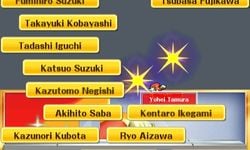
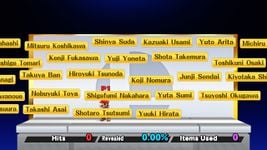
Right: The credits in Super Smash Bros. for Wii U.
The credits return to Classic Mode in both the 3DS and Wii U versions and All-Star Mode, where unlike in the previous games, instead of shooting the names, the player can use their fighter to attack the names. In the background there is a large panel with that fighter's ending image. However, the photo is hidden by a white texture, and must be uncovered. As the player attacks the names, the hit rectangle flies to the background, removing part of the white texture and revealing chunks of the ending image. The player can speed up the credits by pressing the Start button if they wish, but then can not attack the credits while they are fast-forwarded. The player is awarded 1 Gold per 1% of the image. Also, if 99.99% of the image is revealed, the game may choose to automatically round the score up to 100%. Therefore the most a player can receive is 100 Gold.
The background panel does not stay in place, slowly moving up and down throughout the minigame, requiring the player to adjust their attacks accordingly.
In the Wii U version, some of the credits scroll left, instead of all of them scrolling up. As a result, it is more difficult to get a perfect score in the Wii U version than the 3DS version; to alleviate this, Screw Attacks, X Bombs, Super Mushrooms, and Smart Bombs that do not hurt the user can float by on balloons, which can be popped to release the item for use.
The credits music, again entitled Credits, consists of a medley of main themes from all four games of the Super Smash Bros. series, arranged by Torine.
Version 1.0.6 of Smash 4 added additional credits for post-release content, such as voice actors for downloadable characters. If such content is available, then extra credits will appear in the minigame, granting more opportunities for players to complete the image.
In Super Smash Bros. Ultimate[edit]
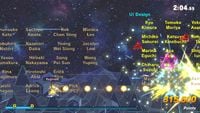
The credits return after beating Classic Mode. Unlike the previous installments, it is a scrolling shooter that changes perspective as the player progresses. The player controls their fighter equipped with a Super Scope to fly around and shoot the names. Charged shots can hit multiple names by passing through them. Players can shoot an explosive item which triggers a Smart Bomb-like explosion to hit nearby names. Along the way, there will be small spaceships which try to either shoot at the player or get in their way; while they do not impede their progress, being hit will temporarily stun them, preventing them from shooting and potentially causing them to miss names. A score is displayed based on names that were hit and a progress bar with rewards is displayed on the bottom left corner. The progress bar will move towards the rewards as the player shoots the names at five different point thresholds: 100,000 points, 300,000 points, 600,000 points, 1,000,000 points and 1,500,000 points. The background is set in space with polygonal landscapes. The camera changes angles when the player progresses in the credits. The player can speed up the credits like in previous Smash Bros. games, which will likewise render them unable to shoot names (although the player can still fire the Super Scope). After the credits, the fighter's ending image can only appear before the final results screen just like in Smash 64. Like in Melee and Brawl, each character has their own separate music based on their own universe.
The credits also appear after completing World of Light and it displays the names. It is set in a black background and the shooting credits game is not in the World of Light's credits. The songs used in the credits for World of Light are Main Theme Piano Solo (If either Galeem or Dharkon is defeated) and Lifelight (If both Galeem and Dharkon are defeated). Main Theme Piano Solo will still play after Lifelight ends in the true ending.
Unlike in Smash 4, post-release content, such as voice actors for other characters from the Persona universe, is not added in Classic Mode's and World of Light's credits. This is due to keeping the credits high score consistent with previous versions for the former, and due to the length of the video for the latter. However, version 3.0.0 added an option to view the credits in the Help menu, which includes content from DLC. The Help menu's credits are set on a black background similar to the World of Light credits, and let the player pause with the A button and fast forward and rewind using the control stick.
Listed below are the tracks that play for each character on Classic Mode's credits.
Trivia[edit]
- In SSB4, if a character from the Mario series is used in the credits sequence, the font used for "Congratulations" changes to a Mario themed font.
- This also applies to its spin-off universes Donkey Kong and Wario, but not Yoshi.
- Similarly, a Street Fighter-themed font is used for Ryu, and a font in the style of the Final Fantasy logo is used for Cloud.
- In Smash 4, attacking the company logos causes a unique sound: "BANDAI NAMCO Games" and "BANDAI NAMCO Studios" cause a Pac-Man eating sound effect, "Nintendo" causes a Game Boy startup sound effect, and "Sora" causes a crowd cheer. In Ultimate, only the Game Boy startup sound is heard upon shooting the Nintendo logo at the end.
- In Ultimate, there is a timer starting at 2:33 and counting down throughout the credits. It is purely aesthetic and does not affect anything, stopping exactly at the time the Nintendo logo would finish leaving the screen if not shot.
- In Smash 64 and Melee, the Pokémon released from Poké Balls do not have their voice actors credited. In the PAL version of Brawl, this is true of their French and German actors.
- The Hero is the only fighter to use differing music depending on a costume.
- The first publicised perfect score of the Melee credits was achieved by Porkyz on February 2, 2021 in the NTSC version.[1][2] The feat was done for YouTuber Nathaniel Bandy's $3,000 bounty for the first publicised perfect score.
References[edit]
External links[edit]
